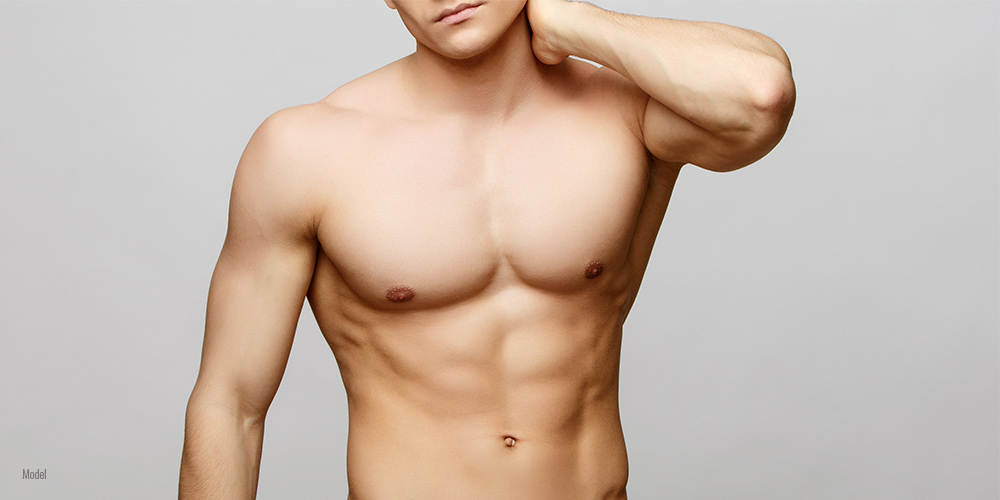
Are you a man who enjoys hot summer days and trips to the pool and beach but is self-conscious about taking off your shirt because of the appearance of your chest? Maybe you’ve been exercising and watching what you eat, but you still can’t get rid of your unwanted “man boobs.” If this sounds familiar, you might have a common medical condition called gynecomastia. In this blog, we’ll go over the types of gynecomastia, whether it will go away on its own, and treatment options if it doesn’t.
4 Min Read:
What Is Gynecomastia?
Gynecomastia occurs when the glandular tissue in a man’s chest increases, causing the appearance of breasts. Besides a change in how your chest looks, gynecomastia symptoms may include pain or tenderness, swelling, or nipple sensitivity. Gynecomastia can affect boys and men of almost any age. In fact, nearly 70% of adolescent males experience it to some degree, as do almost 65% of men middle-aged and older.
What Causes Gynecomastia?
There are several things that can contribute to gynecomastia, but the primary culprit is an imbalance in hormones. Men and women have both testosterone and estrogen hormones in their bodies, but when estrogen levels in men increase and testosterone levels decrease, it can cause male breast tissue to grow. This type of hormonal imbalance typically occurs at different life stages where hormones are more noticeably fluctuating, like during puberty and middle age.
During puberty, hormonal fluctuations can sometimes cause your estrogen levels to be temporarily higher than your testosterone. This hormonal shift can cause you to develop gynecomastia. Once you reach middle age, another wave of hormonal changes occurs. Around the age of 50, your testosterone levels begin to decline gradually, which can once again create an imbalance between testosterone and estrogen in your body. Additionally, the increased body fat that often comes with age can contribute to the problem, as estrogen is produced in fat. This combination of lower testosterone and higher estrogen levels can lead to the development or worsening of gynecomastia in older men.
Other culprits behind a shift in hormones that may lead to gynecomastia include:
- Anabolic steroid use
- Certain medications for anxiety, depression, and ADHD
- Alcohol consumption
- Opioids and recreational drugs
- Health conditions, including kidney or liver failure and hyperthyroidism
- Certain herbal supplements
Will My Gynecomastia Go Away on Its Own?
In some cases, your gynecomastia will go away on its own once your hormones level out. If you have a health condition or take medication that may be contributing to a hormonal imbalance, talk to your doctor to see if your gynecomastia could be a side effect. You may be able to adjust your medication, or you may find out that you have a health condition that needs addressing, both of which could help eliminate your gynecomastia.
However, there may be instances where changing your lifestyle habits or adjusting your medications doesn’t resolve your gynecomastia, which is when you may want to consider surgery.
Can I Treat Gynecomastia by Losing Weight?
While you may think that an increase in the size of your breasts is due to gynecomastia, that isn’t always the case. Weight gain can also cause male breast enlargement, which is called pseudogynecomastia. The primary difference between gynecomastia and pseudogynecomastia is that gynecomastia is due to an increase in glandular tissue, and pseudogynecomastia is due to an increase in fat.
What Are My Options For Treating Gynecomastia?
If your gynecomastia doesn’t go away on its own, you may want to explore your options for gynecomastia surgery, including:
Advanced Liposuction
If your enlarged breasts are primarily due to excess fat (or pseudogynecomastia), advanced liposuction may be the solution. During this procedure, Dr. Lo removes fat through an incision hidden in your armpit, using liposuction to sculpt and contour your chest.
Surgical Gland Removal
If your gynecomastia is due to increased glandular tissue, Dr. Lo removes the excess tissue through a small incision along the bottom of the areola. If you have true gynecomastia, you will require the removal of excess glandular tissue to treat the condition successfully.
Male Breast Reduction
More severe cases of gynecomastia may require a combination of glandular tissue, fat, and excess skin to be removed. If this is the case for you, Dr. Lo will combine the above procedures and may also reposition your nipple and areola to ensure your chest has a natural, masculine appearance.
When you come in for a gynecomastia consultation with Dr. Lo, he will examine you, listen to your concerns, and create a customized treatment plan tailored to your needs.
Learn More About Gynecomastia Treatment in Philadelphia and New Jersey
While gynecomastia is a common medical condition, many men still feel too embarrassed to talk about it or find possible treatment options. Board-certified plastic surgeon Dr. Adrian Lo understands the stigma around gynecomastia and offers compassion and understanding to his patients with gynecomastia, along with highly skilled surgical care. To learn more about gynecomastia treatment and discover if you’re a candidate, call our office today at (215) 829-6900 or complete the online contact form.
